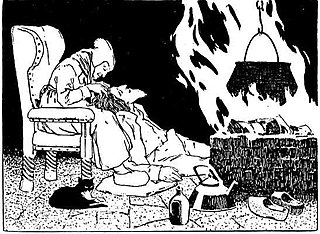
A fairy tale is a short story that belongs to the folklore genre. Such stories typically feature magic, enchantments, and mythical or fanciful beings. In most cultures, there is no clear line separating myth from folk or fairy tale; all these together form the literature of preliterate societies. Fairy tales may be distinguished from other folk narratives such as legends and explicit moral tales, including beast fables. Prevalent elements include dragons, dwarfs, elves, fairies, giants, gnomes, goblins, griffins, merfolk, monsters, talking animals, trolls, unicorns, witches, wizards, magic, and enchantments.
Juan Bautista Rael was an American ethnographer, linguist, and folklorist who was a pioneer in the study of the people, stories, and language of Northern New Mexico and southern Colorado in the Southwestern United States. Rael was a professor at Stanford University. He donated his considerable collection of ethnographic materials to the Library of Congress.

Baile folklórico, "folkloric dance" in Spanish, also known as ballet folklórico, is a collective term for traditional cultural dances that emphasize local folk culture with ballet characteristics – pointed toes, exaggerated movements, highly choreographed. Baile folklórico differs from danzas and regional bailes. Although it has some association from “danzas nationalists". Folk dances", that is, "dances that you will find in the villages, not on stage" were researched and disseminated by Alura Angeles de Flores. Each region in Mexico, the Southwestern United States and Central American countries is known for a handful of locally characteristic dances.

Jean de l'Ours or John the Bear, John of the Bear, John-of-the-Bear, John Bear, is the leading character in the French folktale Jean de l'Ours classed as Type 301B in the Aarne–Thompson system; it can also denote any tale of this type.

"The Devil with the Three Golden Hairs" is a German fairy tale collected by the Brothers Grimm. It falls under Aarne–Thompson classification types 461, and 930.
The Vain Little Mouse is a folktale about a little mouse and her many suitors.
The Bird of Truth is a Spanish fairy tale collected by Cecilia Böhl de Faber in her Cuentos de encantamiento. Andrew Lang included it in The Orange Fairy Book.
The Water of Life is a Catalan fairy tale collected by D. Francisco de S. Maspons y Labros (1840–1901), in Cuentos Populars Catalans (1885). Andrew Lang included it in The Pink Fairy Book (1897).

The Knights of the Fish is a Spanish fairy tale collected by Fernán Caballero in Cuentos. Oraciones y Adivinas. Andrew Lang included it in The Brown Fairy Book. A translation was published in Golden Rod Fairy Book. Another version of the tale appears in A Book of Enchantments and Curses by Ruth Manning-Sanders.
Anthousa, Xanthousa, Chrisomalousa or Anthousa the Fair with Golden Hair is a Greek fairy tale collected by Greek folklorist Georgios A. Megas in Folktales of Greece. Other variants were collected by Michalis Meraklis and Anna Angelopoulou.
The Maiden with the Rose on her Forehead is a Portuguese fairy tale collected by Consiglieri Pedroso in Portuguese Folk-Tales.

Grateful dead is both a motif and a group of related folktales present in many cultures throughout the world.
Folklore of Spain encompasses the folklore, folktales, oral traditions, and (urban) legends of Spain.

Aurelio Macedonio Espinosa Jr. was a professor at Stanford University and an expert on Spanish linguistics, focusing on Spanish American folklore. He was the son of Aurelio Macedonio Espinosa Sr.

Edna Garrido Ramírez, also known as Edna Garrido de Boggs, was a Dominican educator, researcher and folklorist. She is considered a pioneer in the studies of Dominican folklore, for her field research on dances, sayings, riddles, oral tales, popular songs, children's games and other manifestations of folklore and ethnomusicology. She founded the first Dominican Folklore Society in 1946 in Santo Domingo.
The Calumniated Wife is a motif in traditional narratives, numbered K2110.1 in Stith Thompson's Motif-Index of Folk-Literature. It entails a wife being falsely accused of, and often punished for, some crime or sin. This motif is at the centre of a number of traditional plots, being associated with tale-types 705–712 in the Aarne–Thompson–Uther Index of tale-types.
La Fada Morgana is a Catalan fairy tale or rondalla, first collected by Majorcan priest and author Antoni Maria Alcover. It is related to the cycle of the Animal as Bridegroom and distantly related to the Graeco-Roman myth of Cupid and Psyche, in that the heroine is forced to perform difficult tasks for a witch.
The Bird that Spoke the Truth is a New Mexican folktale. It is related to the motif of the calumniated wife and classified in the international Aarne-Thompson-Uther Index as type ATU 707, "The Three Golden Children".
Las barbas de plata is a Spanish fairy tale from Cádiz, published by Spanish scholars Julio Camarena and Maxime Chevalier. It is about the marriage between a human maiden and the Devil disguised as a suitor, but a talking mule rescues the maiden to another kingdom, where she marries a human prince. Spanish and Portuguese scholars locate similar tales in Iberian Peninsula.








